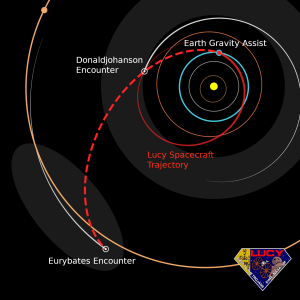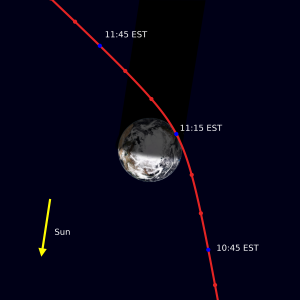UPDATE AS OF DEC. 13, 2024
Shortly after 11:30 p.m. EST, Thursday Dec. 12, NASA’s Lucy spacecraft resumed communications with Earth following the short, planned communication blackout that occurred in the hours around closest approach during its second Earth gravity assist. NASA’s CARA (Conjunction Assessment Risk Analysis) operators determined that no spacecraft maneuvers were necessary to avoid a collision with any satellites or other debris, even though Lucy passed closer to Earth than the International Space Station, which orbits at an altitude of about 250 miles.
While Lucy is now heading toward the Jupiter Trojan asteroids, it will be heading away from Jupiter itself. Although the Trojan asteroids share an orbit with Jupiter, they are, on average, as far away from that planet as it is from the Sun. On Dec. 14, Lucy will pass as “close” as 380 million miles (612 million km, or 4.1 AU) from Jupiter. Lucy will then begin travelling away from that planet, so that the spacecraft will be between 527 and 665 million miles (848 and 1071 million km, or 5.7 to 7.2 AU) from Jupiter during its 2027-2028 Trojan asteroid encounters.
————————————-
On Dec. 12, at 11:15 p.m. EST, NASA’s Lucy spacecraft, currently in a two-year orbit around the Sun, will skim Earth’s atmosphere, passing only about 220 miles (360 kilometers) above the surface. This close flyby will result in a “gravity assist,” putting the spacecraft on a new trajectory that travels through the main asteroid belt and out to the never-before-explored Jupiter Trojan asteroids, small bodies that orbit the Sun at the same distance as Jupiter.

This second Earth gravity assist occurs three years into the Lucy spacecraft’s 12-year voyage. Its first gravity assist on Oct. 16, 2022, one year after launch, boosted the spacecraft from an initial one-year orbit onto the present two-year orbit that reached into the inner limits of the main asteroid belt. This enabled Lucy’s first asteroid encounter with the small asteroid Dinkinesh and its satellite Selam. The upcoming gravity assist will boost the spacecraft into a six-year orbit, one that will carry Lucy through the main asteroid belt (where it will fly past the asteroid Donaldjohanson) and into the Trojan asteroid swarm that leads Jupiter in its orbit, for the first Trojan asteroid encounter in 2027.
During the gravity assist, the Lucy spacecraft, from Earth’s perspective, will approach from the direction of the Sun. This means that observers on Earth will not be able to see Lucy approaching, as it will be lost in the Sun’s glare. Lucy’s trajectory will bring the spacecraft very close to the Earth, even lower in altitude than the International Space Station. To ensure the safety of the spacecraft as it passes through this region full of Earth-orbiting satellites and debris, NASA has procedures to anticipate and avoid potential collisions. If needed, the spacecraft will execute a small trajectory correction maneuver 12 hours before closest approach to alter the time of closest approach by 1 or 2 seconds — enough to avoid a potential collision.

Shortly after sunset, keen observers in the Hawaiian Islands may be able to catch a glimpse of Lucy as the spacecraft approaches Earth before it passes into Earth’s shadow at 6:14 p.m. HST. Lucy will speed over the continental U.S. in darkness, travelling over 33,000 miles per hour (14.8 kilometers per second), and emerge from Earth’s shadow 20 minutes later at 11:34 p.m. EST. At that time, Lucy may be visible to observers with a telescope in the western regions of Africa and the eastern regions of South America as sunlight reflects off the spacecraft’s large solar panels (observers in the eastern United States will be looking at the much dimmer “back” side of the solar panels, making Lucy harder to see; go here for more information about observing Lucy during this gravity assist). Lucy will then rapidly recede from Earth and return to interplanetary space, the gravity assist having increased the spacecraft’s speed with respect to the Sun by over 16,000 miles per hour (7.31 kilometers per second).




